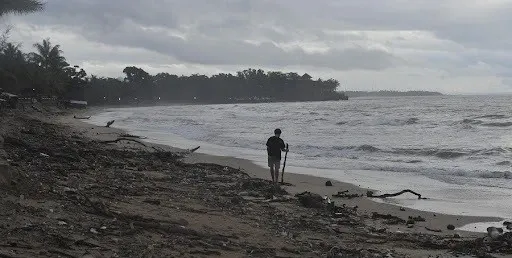Could a Minor Tsunami Affect Indonesia After Russia's Earthquake?

Synopsis
Key Takeaways
- Indonesia's BMKG warns of a potential tsunami following a Russian earthquake.
- Expected tsunami height is less than 0.5 meters.
- Residents in coastal areas should remain calm and avoid the shoreline.
- Official updates can be found through BMKG channels.
- Countries across the Pacific are activating emergency protocols.
Jakarta, July 30 (NationPress) The Indonesian Meteorology, Climatology, and Geophysics Agency (BMKG) has issued a warning regarding a potential tsunami measuring less than 0.5 meters following a strong earthquake in Russia. The agency indicated that this minor tsunami could impact various coastal regions of Indonesia, with varying arrival times anticipated starting from midday.
“Communities residing in the coastal areas at risk are urged to remain calm and to temporarily avoid the shoreline,” stated Daryono, head of BMKG's earthquake and tsunami mitigation division.
Regions that may be affected include parts of Gorontalo, North Maluku, North Sulawesi, West Papua, Papua, and Southwest Papua provinces, specifically Gorontalo City, North Halmahera, Talaud Islands, Sorong, Supiori, Manokwari, Jayapura, Biak Numfor, Sarmi, and Raja Ampat.
Daryono also emphasized the importance of relying on information from official BMKG channels, as reported by Yonhap.
Earlier that day, a massive earthquake with a magnitude of 8.7 struck off the coast of Russia's Kamchatka Peninsula.
The US Geological Survey (USGS) noted that the quake occurred at approximately 23:24 GMT on Tuesday, with its epicenter about 125 km southeast of Petropavlovsk-Kamchatsky, a significant city in Russia's far eastern region.
Originally assessed as an 8.0 magnitude quake, the USGS later updated it to 8.7 based on new data.
This earthquake was recorded at a shallow depth of 19.3 kilometers (12 miles), increasing the potential for intense surface shaking and possible tsunami waves.
The significant tremor prompted a tsunami alert across parts of the Pacific Ocean, with the USGS warning that destructive tsunami waves could impact coastal regions of Russia and Japan within three hours of the quake.
Residents in affected coastal areas have been advised to seek higher ground and adhere to local emergency protocols.
In response to the powerful earthquake off the coast of Russia's Kamchatka Peninsula, numerous countries across the Pacific region have issued urgent tsunami warnings, advising residents to take immediate safety measures.
The quake originated 125 km southeast of Petropavlovsk-Kamchatsky at a depth of 19.3 km, raising concerns about potentially catastrophic tsunami waves across a broad area of the Pacific Ocean.
Consequently, governments and agencies in Japan, the United States (Hawaii), and the Philippines have activated emergency response protocols.
In Japan, the Prime Minister’s Office released a statement emphasizing the need for timely communication with the public concerning the tsunami, evacuation procedures, and damage assessments. They stressed the importance of prioritizing human safety in their emergency response efforts.
The Japan Meteorological Agency (JMA) has issued a tsunami warning for the eastern Pacific coast of Hokkaido and other coastal regions, advising residents to check estimated wave heights and arrival times via their official website.









